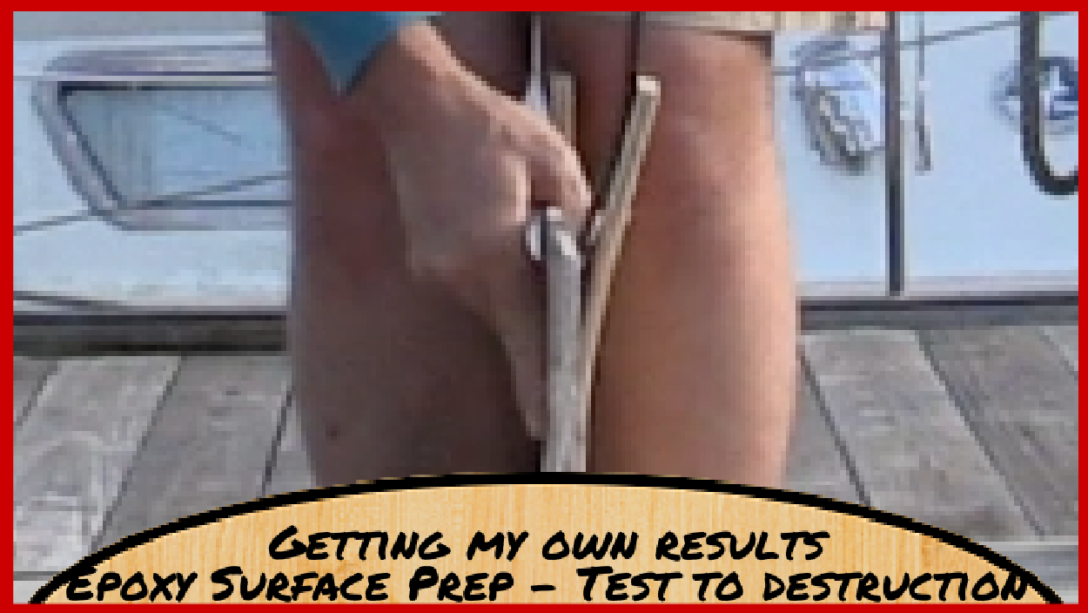Midway through my deck project, I am being faced with a real concern with my decision. I had planned on replacing the rotted core sections of the deck with a mahogany hardwood core and then covering it with epoxy resin and woven roving to build the thickness back up to what the original was. What got me thinking was the cost of the epoxy at first. I am not one to save pennies and risk project results, but the numbers were significantly different enough that it was worth inquiring.
To put the cost difference in perspective, I am using standard retail pricing here. To use 1 gallon of Epoxy Resin with the required hardener, it is about $175 for the resin and hardener. To do this in Polyester Resin, it is about $45 for a gallon and the associated hardener (catalyst). This not be a fair comparison as the epoxy and hardener combined will provide about 1.5 gallons of material, and the polyester will give you about 1.1 gallons due to the much smaller amount of catalyst required in polyester resin. But this is still a huge saving. Just for material, the polyester would cost only 35% of the Epoxy with epoxy running about $116 per gallon and polyester running about $41 per gallon of finished product.
So I went out to a few respected boat repair forums and posed the question, Polyester or Epoxy and provided background on the work that I was going to be performing. I want first to state that people are always generous and amazing with sharing their experience and advice. That said, this turned into a bit of an argument amongst the ‘forum experts’ (I referred to them like this as they are respected contributors within the forum, but I don’t have personal experience with any that provided guidance there) as to which was the better solution.
The tools we use for this job are listed below if you find this a convenient way to shop for them. If you use these links, you get the same great Amazon pricing, but we get a small affiliate link credit. Thank you.
The challenge was that the answers were many times epoxy and many times polyester, and a few times even suggested vinyl-ester, but all of them were adamant their method was the correct one and all cited success examples with their methods. In the end, I came to the conclusion that either would likely be more than adequate for my job as long as I prepared the surface correctly and followed the manufacturer’s instructions for application, temperature, and preparation.
At this point, I bought into the fact that epoxy would have a better mechanical bond between an old and new surface than polyester but wasn’t sure if the “better” difference was required, but I started to lean toward going with Epoxy at this point.
The details of this job are essentially removing all the teak from a teak boat deck, replacing the deck core where it was delaminated and then adding some layers over the entire deck to thicken the whole thing up and ensure none of the 7000 screw holes were still water ingress points. So the question I still had was surface preparation. Did I have to grind all of the existing deck all the way down to raw fiberglass or could I add these layers of fiberglass over the top of a relatively smooth deck and then fair over the upper part of it.
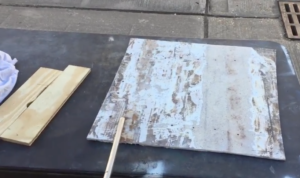 It was time for a test of my own to show how well the bond would be between raw fiberglass and that rougher deck surface that still had some gel coat and maybe paint and maybe some epoxy bond that was holding the teak down.
It was time for a test of my own to show how well the bond would be between raw fiberglass and that rougher deck surface that still had some gel coat and maybe paint and maybe some epoxy bond that was holding the teak down.
I used a piece of the top layer of glass that I had cut out of the boat as my test material. I smoothed a 5″ wide section of the test material and then next to that I ground a 5″ wide section all the way down to the fiberglass.
I also cut two strips of 1/2″ plywood that I would adhere into these two sections. I then mixed up my epoxy and thickened it. I have been using stuff I just bought off the shelf at West Marine for the start of my project, so I continued using West Resin 105, Extra Slow Hardener 209 and a 405 thickening fillet material.
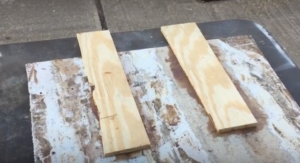 I mixed it up to a peanut butter consistency and put a thin layer of thickened material on the back of each piece of wood and the two spots on the test material.
I mixed it up to a peanut butter consistency and put a thin layer of thickened material on the back of each piece of wood and the two spots on the test material.
I smushed (yep that is a word today) them down onto the surface and set a tool box on top of them to apply pressure while it cured overnight.
It was now time for the test. My goal was to pry each piece of plywood off the surface and collect 2 data points. The first one was how easily the material came off and the second one was where the separation happened.
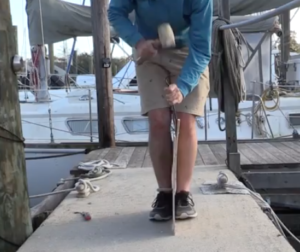 I used a pry bar and started with the board attached to the epoxy, gel coat mixed surface. This piece was tough to get off the material. I struggled to get it to come loose even with the pry bar, and when it did break off, it split the layers of plywood leaving much of the wood still attached to the test material. I used a metal wedge and continued to break more of this off, and where it did come off, it had a bit of white stuff on it, indicating that the epoxy used to glue it down adhered to the existing epoxy and gel coat very well and pulled some of that loose.
I used a pry bar and started with the board attached to the epoxy, gel coat mixed surface. This piece was tough to get off the material. I struggled to get it to come loose even with the pry bar, and when it did break off, it split the layers of plywood leaving much of the wood still attached to the test material. I used a metal wedge and continued to break more of this off, and where it did come off, it had a bit of white stuff on it, indicating that the epoxy used to glue it down adhered to the existing epoxy and gel coat very well and pulled some of that loose.
I then repeated this on the side that was down directly on the raw fiberglass and was surprised that it came off with only about a third of the effort, so much easier to pull off than the side with an existing layer of old material under it. The place it failed was interesting. It didn’t fail at the epoxy joint that I made. That stayed intact and what pulled up was a layer of the raw glass. So while it broke easier, the bond that it made was stronger than that of the side with leftover material on it.
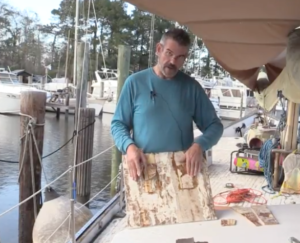 Based on the results, I have come to the conclusion that I don’t have to take the time and effort to grind the entire deck down to raw fiberglass. The test results showed that it had a more even bond, it was weaker than applying the new surface right on top of the existing material as long as that material had been prepared properly.
Based on the results, I have come to the conclusion that I don’t have to take the time and effort to grind the entire deck down to raw fiberglass. The test results showed that it had a more even bond, it was weaker than applying the new surface right on top of the existing material as long as that material had been prepared properly.
This test was a great experiment for me to do. I was able to use my particular material from the deck, with the same material that I am going to be adhering to. I know that this test is accurate for the work I am about to perform.
There is one more test that I think I want to do before I add glass to the entire deck. That is going to be to compare these results to what they would be with a polyester resin based product as well. I think when I do that next test, I am also going to more closely mirror the goals of my project by replacing the plywood in this test with layers of woven roving which is what the ultimate deck will have applied over it.
If you are embarking on a similar project and have questions about the test details and or my results, feel free to reach out to me. The best ways to contact me are via email or one of the social links listed on this page or even comment on the video on youtube.
Feel free to repost this article with embedded video to your favorite sailing group, sailing club or even point them to our youtube channel or Facebook page for more info as well.

